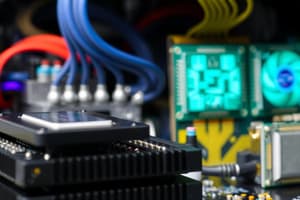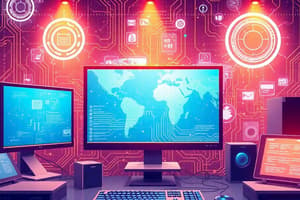Podcast
Questions and Answers
Which of the following statements about closed source software is true?
Which of the following statements about closed source software is true?
- Only original authors can access, copy, and alter the software. (correct)
- Anyone can purchase and share the software.
- It is always free to use.
- Users can freely access and modify the code.
Application software is designed specifically for end users.
Application software is designed specifically for end users.
True (A)
Name a type of software that is essential for the computer to function correctly.
Name a type of software that is essential for the computer to function correctly.
Operating System
The first two versions of the __________ operating system were introduced by Microsoft.
The first two versions of the __________ operating system were introduced by Microsoft.
Match the following types of software with their descriptions:
Match the following types of software with their descriptions:
What is one reason why it is necessary to use a licensed operating system?
What is one reason why it is necessary to use a licensed operating system?
Linux is an example of closed source software.
Linux is an example of closed source software.
What type of operating system was dominant for microcomputers in the 1980s?
What type of operating system was dominant for microcomputers in the 1980s?
___ is an example of a program that allows different applications and hardware components to communicate.
___ is an example of a program that allows different applications and hardware components to communicate.
Which of the following is NOT a type of application software?
Which of the following is NOT a type of application software?
Study Notes
Introduction to Information Technology
- Information Technology (IT) encompasses technologies used to create, collect, process, protect, and store information, including hardware, software, and networks.
- Information and Communication Technology (ICT) facilitates the transfer and use of various types of information, serving as a backbone for economic and social change in the 21st century.
- With advancements, remote access to information is now possible through services like work-from-home, distance education, e-banking, and e-governance.
Data and Information
- Data consists of raw facts including numbers, characters, and text, while information is structured data that provides meaning and context for human understanding.
- Example: "Xyz, 1234, MG Road, Umbar 84084, Calcutta, 9111111111" represents contact information when organized from raw data inputs like "Umbar, 1234."
Computer System Components
- A computer system comprises three fundamental components:
- Input Unit: Allows users to enter data and commands (e.g., keyboard, mouse, touch screens).
- Central Processing Unit (CPU): Processes data and instructions, consisting of:
- Arithmetic and Logic Unit (ALU): Executes mathematical and logical operations.
- Control Unit: Coordinates operations of the computer system.
- Output Unit: Displays processed information, including devices like monitors and printers.
Computer Memory
- Memory is categorized into:
- Primary Memory: Contains data and instructions currently in use; includes RAM (volatile) and ROM (non-volatile).
- Secondary Memory: Long-term storage solutions external to primary memory (e.g., hard disks, USB drives, CDs).
- Computer storage is measured in bytes, with a hierarchy:
- 1 Byte = 8 Bits, 1 KB = 1,024 Bytes, 1 MB = 1,024 KB, 1 GB = 1,024 MB, and so forth.
Computer Architecture
- Describes the design and interaction of hardware and software within a computer system, detailing how they work together.
Hardware and Software
- Hardware: Physical components of a computer that can be seen and touched, including the motherboard, CPU, and peripherals.
- Software: Instructions or programs that allow users to interact and perform specific tasks on hardware.
- Open Source Software: Publicly available software that can be modified and shared freely (e.g., Linux).
- Closed Source Software: Proprietary software that limits user access to the source code, requiring purchase for use.
Operating Systems
- An operating system (OS) is essential for computer functionality, managing hardware-software interaction.
- Examples include Windows, macOS, Linux, and mobile OS like Android and iOS.
- Users are advised to utilize licensed or open source operating systems for security and compliance, avoiding pirated versions.
Types of Software
- Application Software: Designed for end users, including word processors, web browsers, and spreadsheet programs.
- System Software: Enables computer hardware to function correctly, operating systems being a key example.
Memory Units
- Bit: The smallest unit of data.
- Nibble: 4 bits.
- Byte: 8 bits; forms the basis for larger data measurements.
- Memory components include a variety of external and internal storage solutions.
Importance of Information
- Information is crucial for decision-making in organizations, influencing both short-term and long-term strategies, reflecting the significance of IT in everyday life.
Studying That Suits You
Use AI to generate personalized quizzes and flashcards to suit your learning preferences.
Description
This quiz covers the fundamental concepts of Information Technology (IT) and Information and Communication Technology (ICT). Topics include the definition of IT, types of operating systems, computer architecture, memory units, internet networking, and current trends in IT-enabled services and careers. Engage with essential IT concepts and enhance your knowledge in this ever-evolving field.




